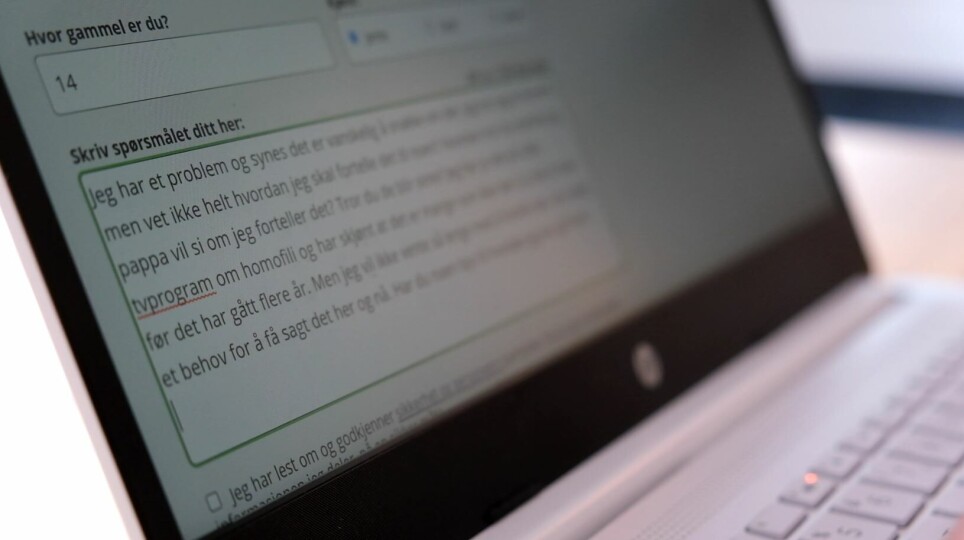THIS ARTICLE/PRESS RELEASE IS PAID FOR AND PRESENTED BY SINTEF - read more

Using the internet to identify signs of depression in young people
Is it possible to identify signs of depression by analysing the content young people post online and in chat rooms? The answer is yes!
Research shows that symptoms of depression can be revealed by a person’s choice of words and sentences, and the context that links them together.
The Norwegian website Ung.no is a resource much used by children and young people, enabling them to find information and ask questions about topics such as school, contraception, drugs and alcohol, family and friends, as well as violence and abuse. All the information on the website is quality assured by experts in the relevant fields. It also offers a live chat service. In other words, the website is the perfect place to conduct research into young people and their lives.
When researchers from SINTEF and the University of Oslo (UiO) were working on the research project called 'Social Health Bots', which is aimed at identifying new, digital solutions to help young people with their mental health issues, they came up with the following idea; What if they could identify symptoms of depression in the content young people are posting online? According to figures from the World Health Organisation (WHO), more than 300 million people across the world are suffering from depression, and many of these are young and vulnerable.
The answer to the researchers’ question proved to be yes. This work, which has been coordinated by SINTEF research scientist Zia Uddin, has now been published in a recognised peer-reviewed journal. The researchers have succeeded in identifying signs of depression by using algorithms to analyse the posts written by young people on the website Ung.no.
“Using algorithms to identify depression may open the door to giving young people the help they need much faster than is possible today," says Petter Bae Brandtzæg, who is a psychologist and researcher at SINTEF and UiO. “Such a system can be offered as part of future health service provision."
Clinical competence at the heart of the matter
Kim Kristoffer Dysthe at UiO is a medical doctor who has worked with young people and their mental health for many years, and has contributed his clinical competence to the project.
“It’s essential to ensure that such a system is people-centred. For this reason, we’ve not only examined the words and sentences used by the young people, but also their communication patterns. We’ve then correlated this content with our existing diagnosis system for depression,” explains Dysthe, who also has a background in linguistics.

According to Dysthe, the words and phrases used by young people to describe what they are struggling with agree amazingly well with the symptoms set out in the DSM-5 diagnosis manual used in the treatment of, and research into, mental illnesses.
“When they ask questions on the website Ung.no, they often tell the story of their previous life experiences,” he says. “They then go on to describe the events that are triggering the thoughts they have about their current situation, and end up by talking about the behaviours and symptoms these events have caused. Often, this content is easily recognisable as a sign of depression.”
Content such as this is ideal for training artificial intelligence software to recognise symptoms of depression. Standard indications of depression include feelings of sadness, a loss of interest in activities that were previously very engaging, difficulties in concentration, tiredness, listlessness and thoughts of suicide. But such signs are not always equally unambiguous. Language, choice of words and narrative styles can also reveal signs of depression.
A vulnerable group in need of urgent help
When it comes to depression, young people are a vulnerable group. Our youth is a very important time for the development of our emotional habits and mental health. Emotional habits can encompass everything from our sleep patterns, regular exercise, problem-solving skills, communication with others, as well as how we cope with our different feelings.
It is very important to experience social support during this developmental stage. Between ten and twenty percent of young people experience mental health problems, but the majority remain undiagnosed and thus do not receive any treatment.
Artificial intelligence identifies patterns and signs of depression
SINTEF researcher Zia Uddin has been working with artificial intelligence and algorithms for many years. He says that the ‘deep learning’ method applied in this project is a well-established approach in the field of machine learning, or so-called artificial intelligence.
“The researchers have applied artificial intelligence algorithms to recognise and make comparisons between words, sentences and expressions, and the context that links them together,” Uddin says. “The system is now able to recognise signs of depression and melancholy, and this will open opportunities for the development of a digital solution that can provide urgently needed help to sufferers."
Teaching psychology to algorithms
When algorithms are being trained, they are asked to sort through a given number of posts that in fact have nothing to do with depression, all mixed up with others that are clearly depression-related. All the content is anonymised.
“We’re seeing an increase in the incidence of mental illness, especially among young people, and during this current pandemic in particular. Capacity in treatment provision is at breaking point and our aim is to develop a low threshold service that can make a useful contribution,” says Brandtzæg.
Useful information and rapid response
Both Brandtzæg and Dysthe agree that rapid assistance and individually-adapted preventive assistance is crucial to the young person concerned. In some situations it may be sufficient that a young person in despair is reassured that it is quite normal to experience depression and that he or she is not alone in this; that treatment is available and that in the vast majority of cases their condition will pass as long as they receive help.
“It’s important for us to emphasise that our solution is not a replacement for the help offered by the public health services. However, it can be used to provide first line assistance, to disseminate knowledge and to encourage young people to seek active help from a doctor or psychologist – all thanks to artificial intelligence and quality assured content,” says Dysthe.
“The most important thing is to offer young people hope and the knowledge that what they are undergoing can be addressed,” he adds.
The research team is now continuing its work to develop specific systems that can provide individually tailored information to young people who are showing signs of depression when they post content on the Ung.no website. This can be done by means of dialogue with a chatbot or other digital tools that can apply artificial intelligence to the provision of personalised support and ‘help for self-help’ to young people.
This research has been published as ‘Open Access’ in the journal Neural Computing and Applications, which is a recognised, Q1-ranked, journal for research articles in the fields of IT and artificial intelligence, with a JCR factor of 5.61.
Reference:
Uddin, K. K. Dysthe, A. Følstad, and P. B. Brandtzæg, "Deep learning for prediction of depressive symptoms in a large textual dataset,"Neural Computing and Applications, Aug. 2021.
See more content from SINTEF:
-
New study: Even brand-new apartments in cities can have poor indoor air quality
-
Fresh hope for patients with chronic inflammatory bowel disease
-
Testing a giant ship: May take five kilometres to stop
-
A robot is helping researchers hunt for the best cancer warriors
-
Locomotives that run on diesel can be electrified
-
Where kelp is being turned into lab-grown meat





































